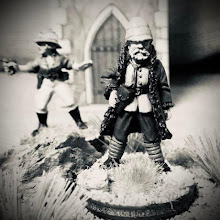My next unit for the British Indian Army, using the rules The Men Who Would be Kings are the 130th King George's Own Baluchis (Jacob's Rifles) which was an infantry regiment of the British Indian Army raised in June 1858 as the 1st Belooch Rifles; re-designated as 1st Regiment Jacob's Rifles in September. It was designated as 130th Jacob's Baluchis in 1903 becoming the 5th Battalion (King George's Own) 10th Baluch Regiment (Jacob's Rifles) in 1922. In 1947, it was allotted to Pakistani Army, where it continues to exist as 12th Battalion of The Baloch Regiment.
In 1858, Major John Jacob raised two local 'silladar' (a soldier that provides his own arms and is paid more) infantry battalions known as Belooch Rifles (re-designated as Jacob's Rifles soon after); the only silladar infantry to have existed in the Indian Army. These battalions soon earned a formidable reputation in and around Jacobabad for keeping the peace on the Sindh frontier as part of the Sind Frontier Field Force.
Brigadier General John Jacob (1812-1858), engraving of 1859 by Thomas
Lewis Atkinson, after unknown original artist. Identical to National
Portrait Gallery, London: NPG 2186a.
In 1861, the first of these was accorded regular
status, becoming the 30th Regiment of Bombay Native Infantry or Jacob's Rifles, while the second was disbanded. The regiment fought in the Second Afghan War of 1878–80 and suffered heavy casualties at the Battle of Maiwand.
In 1881, it was reconstituted as a Baluch battalion and re-designated
as the 30th Regiment (Jacob's) Bombay Native Infantry or 3rd Belooch
Regiment. In 1900, it was sent to China to suppress the Boxer Rebellion.
Subsequent to the reforms brought about in the Indian Army by Lord Kitchener in 1903, all former Bombay Army units had 100 added to their numbers, and the regiment's designation was changed to 130th Jacob's Baluchis. In 1906, the Prince of Wales (later George V) was appointed Colonel-in-Chief of the regiment. The regimental full dress uniform in 1914 included a rifle green turban and kurta (knee length tunic) piped in red, worn with red trousers and white gaiters. The red trousers were a distinctive feature of all five Baluch infantry regiments then serving in the Indian Army.
Badge of 130th King George's Own Baluchis (1903-22), now 12 Baloch, an infantry battalion of Pakistan Army. (Attribution: - Photograph of a badge in his personal collection.)
I've decided to paint Jacob's Rifles as they may have appeared in the 2nd Afghan War. During that period, uniforms were transitioning to khaki, but not all of the regiments all at once; many held on to distinctive turbans or unique aspects of their uniforms. The Lieutenant Colonel (later Field Marshal Lord) Birdwood wrote in a note preserved at Sandhurst that the 11th (Prince of Wale's Own) Bengal Lancers were on active service in the field against the enemy still wearing blue kurtas. Let's face it, a little color with all of that khaki looks good!
Jacob's Rifles will also show up in my fictional "Anglo-Russian War" probably as one of the units of the fictional Princely State of Chaimbellistan. As you probably noticed, I used the alternative basing for The Men Who Would be Kings which I am starting to like more and more; especially for a "large" skirmish game.












Nice Perry figures very nicely painted Neil...I hope they get into action very soon!
ReplyDeleteMe too!
DeleteAn unusual and handsome unit, Neil!
ReplyDeleteThanks. They definitely standout on the table.
DeleteNeil
Vary nice figures. Love TMWWBK's, it's a great set of rules
ReplyDeleteBig Lee,
DeleteI agree. I've been a fan of the Mersey series of rules for a long time now. Thanks for the comment about the figures; as usual the Perry brothers do a great job making them easy to paint.
Neil